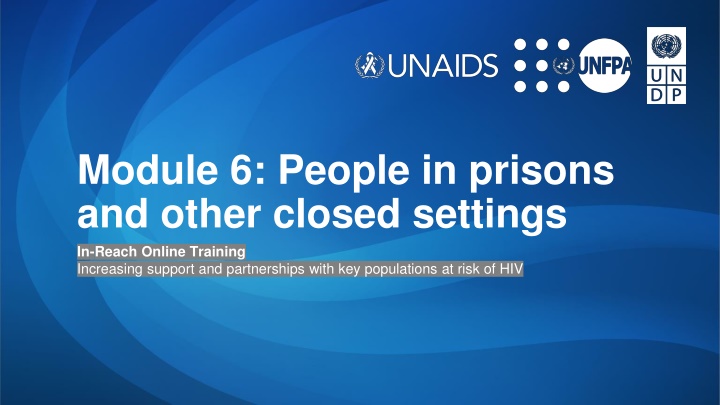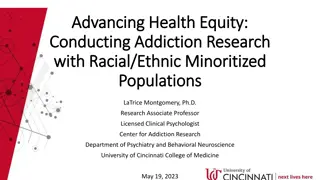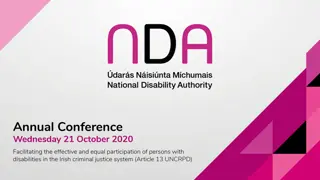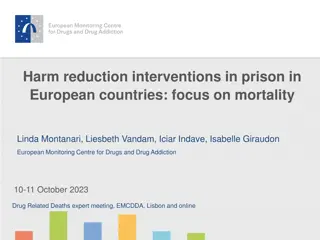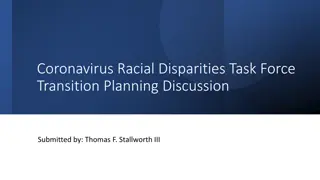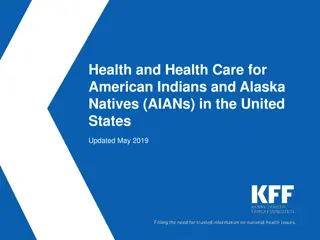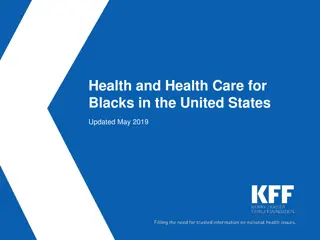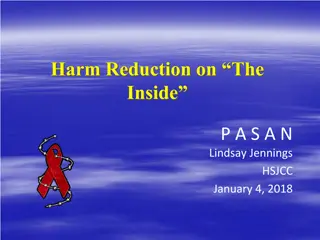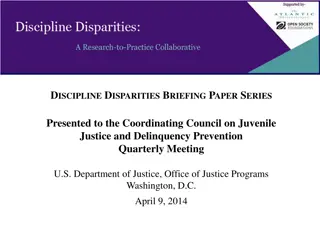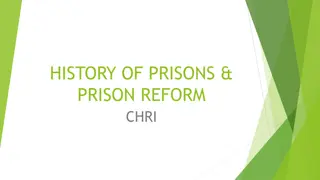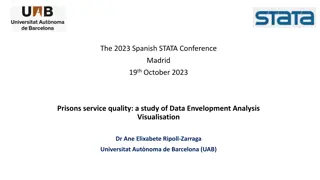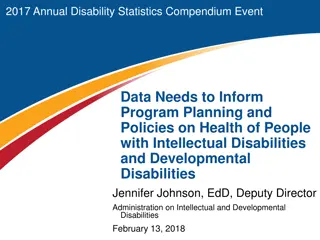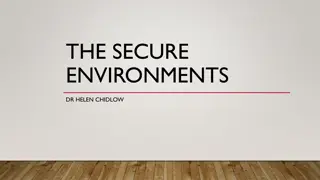Addressing Health Disparities in Prisons: Module 6 Overview
People in prisons face higher rates of HIV, viral hepatitis, STIs, and TB but often lack access to quality healthcare. Module 6 focuses on promoting health and human rights in closed settings, drawing on UN guidance. Framing questions challenge misconceptions about healthcare and prevention services for incarcerated populations.
Download Presentation

Please find below an Image/Link to download the presentation.
The content on the website is provided AS IS for your information and personal use only. It may not be sold, licensed, or shared on other websites without obtaining consent from the author.If you encounter any issues during the download, it is possible that the publisher has removed the file from their server.
You are allowed to download the files provided on this website for personal or commercial use, subject to the condition that they are used lawfully. All files are the property of their respective owners.
The content on the website is provided AS IS for your information and personal use only. It may not be sold, licensed, or shared on other websites without obtaining consent from the author.
E N D
Presentation Transcript
Module 6: People in prisons and other closed settings In-Reach Online Training Increasing support and partnerships with key populations at risk of HIV
Introduction Around the world, people in prisons and other closed settings experience higher prevalence rates of HIV compared with the rest of the population. In many countries there is also evidence of higher rates of viral hepatitis B and C, sexually transmitted infections (STIs) and tuberculosis (TB). Although they are entitled to the same quality of healthcare as is available in the general community, people in prisons and other closed settings often do not receive it, either because of inadequate resourcing, or because of punitive policies or practices that deprive them of the care they need. This module covers the elements of programmes and approaches that UN organisations can develop to promote the health and human rights of people in prisons and closed settings. It draws upon the WHO Key Populations Consolidated Guidelines, 2022, as well as other UN-endorsed guidance. MODULE 6 | INTRODUCTION UNITED NATIONS DEVELOPMENT PROGRAMME
Module 6 Contents Questions to frame this module Some definitions Vulnerability of people in prisons and other closed settings Health interventions for people in prisons and other closed settings UN frameworks and normative guidance on people in prisons and other closed settings Take-home messages Module review questions Further information and resources UNITED NATIONS DEVELOPMENT PROGRAMME
Framing questions 1. It is a state s responsibility to ensure that people in prisons and other closed settings have access to the same standard of health care that is available in the wider community. Agree Disagree Not sure 2. There is almost no illegal drug use or sex in prisons, so people in prisons are better protected from HIV than those in the wider community. Agree Disagree Not sure MODULE 6 | QUESTIONS TO FRAME THIS MODULE UNITED NATIONS DEVELOPMENT PROGRAMME
Framing questions 3. The Sustainable Development Goals call for people in prisons and other closed settings to access the same HIV prevention services as other key populations. Agree Disagree Not sure 4. People in prisons and other closed settings are not capable of running harm reduction programmes for drug use themselves. Agree Disagree Not sure MODULE 6 | QUESTIONS TO FRAME THIS MODULE UNITED NATIONS DEVELOPMENT PROGRAMME
Framing questions: Responses 1. Correct. People in prisons and other closed settings have the same rights to health care as those in the general community. 2. Incorrect. There is significant drug use and sex in prisons, but frequently there are few or no services for HIV prevention, making people in prisons even more vulnerable to HIV than those in the general community. 3. Correct. People in prisons and other closed settings need the same services for HIV prevention, diagnosis and treatment as other key populations. 4. Incorrect. People who use drugs can run effective harm reduction services, and this is true in prisons as well as in the general community. MODULE 6 | QUESTIONS TO FRAME THIS MODULE UNITED NATIONS DEVELOPMENT PROGRAMME
Module 6 Contents Questions to frame this module Some definitions Vulnerability of people in prisons and other closed settings Health interventions for people in prisons and other closed settings UN frameworks and normative guidance on people in prisons and other closed settings Take-home messages Module review questions Further information and resources UNITED NATIONS DEVELOPMENT PROGRAMME
Some definitions Prisons and other closed settings refers to all places of detention within a country that hold people who are awaiting trial, those who have been convicted, or people who are subject to other conditions of security. Prisoners and detainees refers to all those detained in criminal justice and prison facilities including adult and juvenile males, females, trans and gender-diverse individuals during the investigation of a crime, while awaiting trial, after conviction, before sentencing and after sentencing. The issues considered in this In-Reach training also apply to those detained for reasons relating to immigration or refugee status, those detained without charge, and those sentenced to compulsory treatment and to rehabilitation centres. Prison staff are also affected by HIV, viral hepatitis, STIs and other health issues, and may lack access to health services, particularly if they live in prison compounds without health services. Source: Consolidated guidelines on HIV, viral hepatitis and STI prevention, diagnosis, treatment and care for key populations (WHO, 2022) MODULE 6 | SOME DEFINITIONS UNITED NATIONS DEVELOPMENT PROGRAMME
Module 6 Contents Questions to frame this module Some definitions Vulnerability of people in prisons and other closed settings Health interventions for people in prisons and other closed settings UN frameworks and normative guidance on people in prisons and other closed settings Take-home messages Module review questions Further information and resources UNITED NATIONS DEVELOPMENT PROGRAMME
Vulnerability of people in prisons and other closed settings It is estimated that on any given day, there are around 11 million people in prison. Globally, on average, 4.2% of people held in prisons are living with HIV. 5 times Of the total prison population: 15.1% have viral hepatitis C 4.8% have chronic hepatitis B 2.8% have active TB. People in prisons are 5 times more likely to be living with HIV than adults in the general population Sources: HIV and People in Prisons and Other Closed Settings. Human Rights Fact Sheet Series No. 6 (UNAIDS, 2021); Global AIDS Update 2022 (UNAIDS, 2022) MODULE 6 | VULNERABILITY OF PEOPLE IN PRISONS AND OTHER CLOSED SETTINGS UNITED NATIONS DEVELOPMENT PROGRAMME
What makes people in prisons and other closed settings vulnerable? Many interlinked factors lead to the high vulnerability of people in prisons to HIV, hepatitis B and C and TB. Sex workers, people who use drugs, trans and gender-diverse people and men who have sex with men are often over-represented in prison settings, especially in countries where these populations are criminalised. Many people in prisons have intersecting vulnerabilities, including being poor, being members of racial or ethnic minorities, or having little or no formal education. Transmission of HIV and viral hepatitis occurs within prisons because of unprotected sex, sharing of drug injection equipment, tattooing and sexual violence. Due to poor infection control practices, overcrowding and poor ventilation, people in prisons are also highly vulnerable to TB (including multi-drug-resistant TB). There is a deficit of access to health and justice services for detainees. HIV, viral hepatitis and TB prevention initiatives are often unavailable or inadequate in prisons. MODULE 6 | VULNERABILITY OF PEOPLE IN PRISONS AND OTHER CLOSED SETTINGS UNITED NATIONS DEVELOPMENT PROGRAMME
Module 6 Contents Questions to frame this module Some definitions Vulnerability of people in prisons and other closed settings Health interventions for people in prisons and other closed settings UN frameworks and normative guidance on people in prisons and other closed settings Take-home messages Module review questions Further information and resources UNITED NATIONS DEVELOPMENT PROGRAMME
The right to health of people in prisons and other closed settings (1) Several internationally recognised documents have enshrined the right to health services for prisoners that are equivalent to those outside of prisons. Respect for these norms should be reflected in prison policies and practices. The United Nations Standard Minimum Rules for the Treatment of Prisoners (the Nelson Mandela Rules, 2015) state (Rule 24): 1. The provision of health care for prisoners is a State responsibility. Prisoners should enjoy the same standards of health care that are available in the community, and should have access to necessary health-care services free of charge without discrimination on the grounds of their legal status. 2. Health-care services should be organised in close relationship to the general public health administration and in a way that ensures continuity of treatment and care, including for HIV, tuberculosis and other infectious diseases, as well as for drug dependence. MODULE 6 | HEALTH INTERVENTIONS FOR PEOPLE IN PRISONS AND OTHER CLOSED SETTINGS UNITED NATIONS DEVELOPMENT PROGRAMME
The right to health of people in prisons and other closed settings (2) The United Nations Rules for the Treatment of Women Prisoners and Non- custodial Measures for Women Offenders (the Bangkok Rules, 2011) state that gender-specific health-care services at least equivalent to those available in the community shall be provided to women prisoners (Rule 10) and specify the kinds of healthcare and supportive services that should be available to women, pregnant and breastfeeding women and mothers with children in prison, and juvenile females. MODULE 6 | HEALTH INTERVENTIONS FOR PEOPLE IN PRISONS AND OTHER CLOSED SETTINGS UNITED NATIONS DEVELOPMENT PROGRAMME
Interventions for people in prisons and other closed settings (1) People in prisons and other closed settings have varied and complex needs which should be addressed during incarceration, during transfers within and between prisons, and after release, to ensure continuity of care. An adequate health service package should place attention on prevention, diagnosis and treatment of HIV, viral hepatitis, STIs, TB, mental health and drug use. The WHO Key Populations Consolidated Guidelines, 2022 recommend that all interventions in the comprehensive package (outlined in Module 1, Session 1.3) for HIV, viral hepatitis and STI prevention, diagnosis and treatment should be available to people in prisons and other closed settings.* WHO recommends that this package should include condoms and lubricant and harm reduction interventions (needle/syringe programmes, opioid agonist maintenance therapy and naloxone for overdose management), given that drug use is prevalent in prisons. *Gender-affirming care is the only intervention not explicitly included in the package for people in prisons. MODULE 6 | HEALTH INTERVENTIONS FOR PEOPLE IN PRISONS AND OTHER CLOSED SETTINGS UNITED NATIONS DEVELOPMENT PROGRAMME
Interventions for people in prisons and other closed settings (2) The Technical Brief on HIV Prevention, Testing, Treatment, Care and Support in Prisons and Other Closed Settings (UNODC, ILO, WHO, UNFPA, UNAIDS, UNDP, 2020) provides further detail on the comprehensive package of interventions and recommends five additional interventions: Information, education and communication Prevention of sexual violence Prevention of transmission through medical and dental services Hepatitis B vaccination and prevention of transmission through tattooing, piercing and other forms of skin penetration Protecting staff from occupational hazards MODULE 6 | HEALTH INTERVENTIONS FOR PEOPLE IN PRISONS AND OTHER CLOSED SETTINGS UNITED NATIONS DEVELOPMENT PROGRAMME
Case study: Community-led responses in Mexico The COVID-19 pandemic has revealed serious human-rights concerns for people in prisons, with high rates of COVID-19 and associated mortality. More than 500,000 people in prisons are estimated to have been infected in 2020. The Mexican movement for Positive Citizenship works to promote the empowerment of people living with HIV in prisons. The organisation received a grant from UNAIDS to support its efforts on HIV and COVID-19 in Santa Martha Acatitla Penitentiary, where around 9% of the roughly 2,000 inmates were living with HIV. These inmates were concentrated in a single, overcrowded dormitory where physical distancing was difficult, hygiene standards were low and there was little protective equipment for COVID-19. Each of the prisoners living with with HIV received face coverings and other protective equipment, as well as training, helping them to keep their rooms and their personal possessions clean and to wash their hands regularly. A further 1,000 prison inmates also benefited from the project. Source: Protecting prisoners from HIV and COVID-19 in Mexico (UNAIDS, 2021) MODULE 6 | HEALTH INTERVENTIONS FOR PEOPLE IN PRISONS AND OTHER CLOSED SETTINGS UNITED NATIONS DEVELOPMENT PROGRAMME
Module 6 Contents Questions to frame this module Some definitions Vulnerability of people in prisons and other closed settings Health interventions for people in prisons and other closed settings UN frameworks and normative guidance on people in prisons and other closed settings Take-home messages Module review questions Further information and resources UNITED NATIONS DEVELOPMENT PROGRAMME
UN frameworks and normative guidance In addition to the Nelson Mandela Rules already described in this module, the following UN frameworks are relevant to understanding and advocating for the rights of people in prisons and other close settings to health-related services. UN Political Declaration on HIV and AIDS (2021): In this document, drafted at the High Level Meeting on HIV and AIDS in 2021, governments, express deep concern about stigma, discrimination, violence and restrictive and discriminatory laws and practices that target people living with, at risk of and affected by HIV and laws that restrict the movement or access to services for people living with, at risk of and affected by HIV, including key populations and in this regard, deplore acts of violence and discrimination in all regions of the world against them . Consolidated Guidelines on HIV, Viral Hepatitis and STI Diagnosis, Prevention, Treatment and Care for Key Populations (2022): Published by the World Health Organisation, this is an updated version of the 2016 edition, and is designed to address HIV, viral hepatitis and STIs in key populations using a rights-based, integrated and person-centred approach. One of the recommendations is that Countries should work towards implementing and enforcing antidiscrimination and protective laws, derived from human rights standards, to eliminate stigma, discrimination and violence against people from key populations . MODULE 6 | UN FRAMEWORKS AND NORMATIVE GUIDANCE UNITED NATIONS DEVELOPMENT PROGRAMME
The Global AIDS Strategy The Global AIDS Strategy 2021-2026 (2021) sets the following targets regarding people in prisons and other closed settings. By 2025: 95% of people in prisons and other closed settings know their status, 95% who know their status are on treatment and 95% on treatment are virally suppressed (the 95-95-95 targets) 100% of prisoners have regular access to appropriate health system or community-led services 90% of prisoners used condoms at last sexual activity with a non-regular partner 90% of prisoners who inject drugs used sterile needles and syringes at last injection 15% of prisoners use pre-exposure prophylaxis in very high-risk settings* 90% of prisoners have access to post-exposure prophylaxis 90% of prisoners have access to integrated HIV, TB and hepatitis C services. *Very high risk is defined as a national adult HIV prevalence of more than 10%. MODULE 6 | UN FRAMEWORKS AND NORMATIVE GUIDANCE UNITED NATIONS DEVELOPMENT PROGRAMME
Module 6 Contents Questions to frame this module Some definitions Vulnerability of people in prisons and other closed settings Health interventions for people in prisons and other closed settings UN frameworks and normative guidance on people in prisons and other closed settings Take-home messages Module review questions Further information and resources UNITED NATIONS DEVELOPMENT PROGRAMME
Take-home messages International human-rights obligations recognise that people in prisons have the same rights as everyone else (except for lawful limitations caused by incarceration). People in prisons are disproportionately affected by HIV, hepatitis B and hepatitis C. Poor and unsanitary living conditions increase vulnerability and mortality to TB and COVID-19 for detainees and prison staff. People in prisons have the right to the same standard of health care that is available in the wider community, and to accessible health services, including for HIV and TB, without discrimination. Health service packages in prisons should include essential prevention tools for HIV, viral hepatitis and TB, as well as harm reduction for people who use drugs. MODULE 6 | TAKE-HOME MESSAGES UNITED NATIONS DEVELOPMENT PROGRAMME
Module 6 Contents Questions to frame this module Some definitions Vulnerability of people in prisons and other closed settings Health interventions for people in prisons and other closed settings UN frameworks and normative guidance on people in prisons and other closed settings Take-home messages Module review questions Further information and resources UNITED NATIONS DEVELOPMENT PROGRAMME
Module 6 Contents Questions to frame this module Some definitions Vulnerability of people in prisons and other closed settings Health interventions for people in prisons and other closed settings UN frameworks and normative guidance on people in prisons and other closed settings Take-home messages Module review questions Further information and resources UNITED NATIONS DEVELOPMENT PROGRAMME
Further information and resources HIV and People in Prisons and Other Closed Settings. Human Rights Factsheet Series #6 (UNAIDS, 2021) IN DANGER: UNAIDS Global AIDS Update 2022 (UNAIDS, 2022) Key Populations Atlas (UNAIDS) HIV prevention, testing, treatment, care and support in prisons and other closed settings: a comprehensive package of interventions (UNODC, WHO, ILO, UNDP, UNAIDS, UNFPA, 2020) Technical Brief: Transgender People and HIV in Prisons and Other Closed Settings (UNAIDS, UNDP, UNFPA, UNODC, WHO, Penal Reform international, 2022) United Nations Standard Minimum Rules for the Treatment of Prisoners: The Nelson Mandela Rules (United Nations, 2015) United Nations United Nations Rules for the Treatment of Women Prisoners and Non-custodial Measures for Women Offenders: The Bangkok Rules (United Nations, 2011) MODULE 6 | FURTHER INFORMATION AND RESOURCES UNITED NATIONS DEVELOPMENT PROGRAMME
